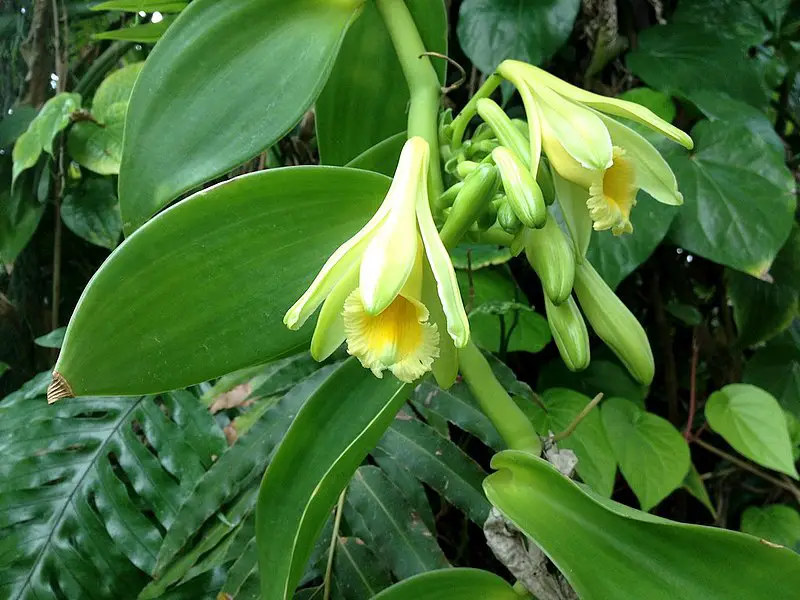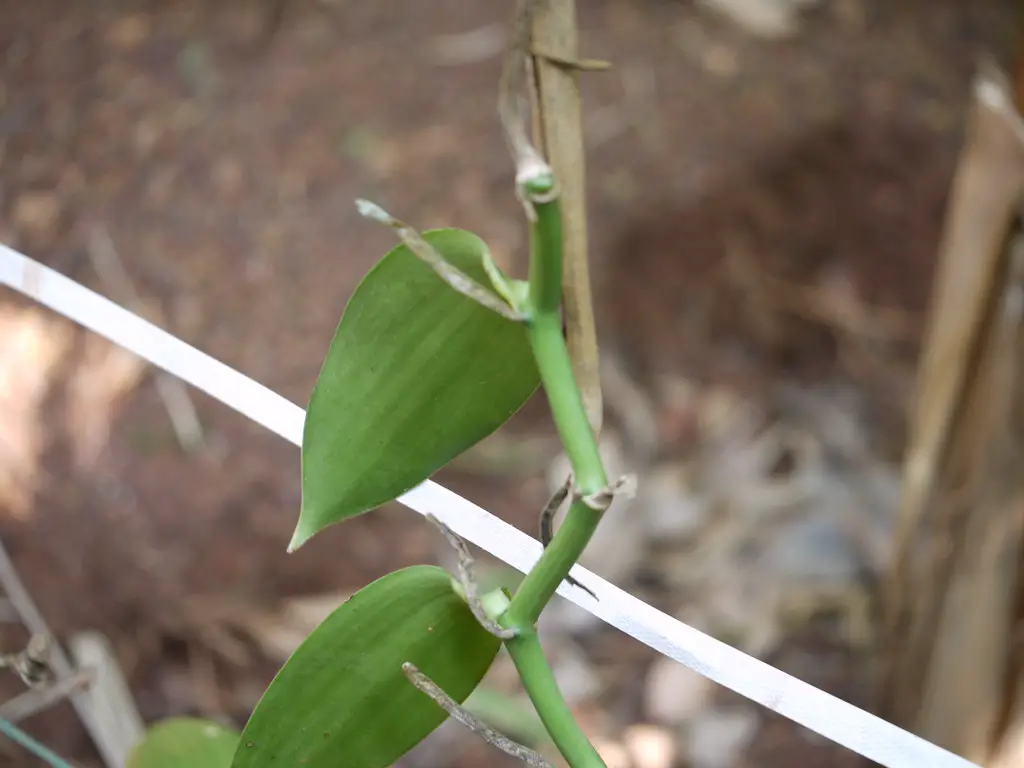Vanilla planifolia, is a vining orchid that is responsible for the vanilla flavors we enjoy in ice cream, cake, coffee, and other treats. Personally, I love vanilla. Recently, I have become more interested in growing some of my own food in order to save money and provide more nutritious food for my family. Vanilla beans are very expensive, and I have become interested in finding out whether I could grow my own vanilla indoors. So I did a little research.
It is possible to grow your own vanilla indoors as long as your vanilla bean orchid is exposed to enough sunlight. However, it will take a long time to grow vanilla bean pods. It can take a vanilla bean orchid 3 to 5 years to produce vanilla beans even in ideal conditions. When growing a vanilla bean orchid as a houseplant, you should provide the plant with some sort of support like a wooden post or slab of wood.
The rest of this blog post is a detailed care guide that will help you decide whether a vanilla bean orchid would make a good addition to your plant family.
About Vanilla Plants
Vanilla planifolia is one of 110 species of plants in the Vanilla genus. Vanilla plantifolia is native to tropical rainforests Mexico. The Aztecs first used vanilla to flavor cocoa. Today, vanilla is commercially produced in Madagascar, Reunion Island, Comoro Island, Indonesia, and Mexico.
Interestingly, Vanilla Plants are a vining orchid that likes to climb trees and other structures. Like many other types of orchids, they are epiphytic meaning that they tend to grow on trees rather than on the ground in the wild.

How Vanilla Plants Flower
Like other orchids, Vanilla Plant is a flowering plant. Once a Vanilla Plant blooms, the flower will only last for a couple of hours. After blooming, the plant will form a pod.

In nature, flowering times differ depending on the region of the world. Ideally, Vanilla Plants will produce their first flowers 2-3 months following the third year after planting (Bouriquet, 1954). This means you should not expect to be making homemade vanilla extract a few months after planting.
An article published in Nature during 1961 gave some tips for encouraging your Vanilla Plant to flower. Their suggestions are as follows:
- Train the Vanilla Plant to climb to a height that is convenient for pollinating and harvesting. According to Bourlquet (1954), limiting the vine’s natural tendency to climb encourages the plant to flower.
- Bending the vine seems to encourage Vanilla Plant to flower and fruit beyond the bend. This may be due to the accumulation of carbohydrates in the vine. (Childers, 1948).
When you are growing Vanilla Plants indoors, it is important to make sure that your plant is in an environment with enough light and humidity (at least 50%).
After a Vanilla Plant flowers, you need to pollinate the plant if you want the plant to produce beans.
Pollinating Vanilla
There is only one insect that can pollinate Vanilla Plant. This insect is the stingless Melipona bee, which is native to Mexico. Because Vanilla Plant can only be pollinated by this one bee, only 1% of Vanilla Plants are pollinated this way (Fouche and Jouve, 1999). To ensure that your Vanilla Plant will produce beans after flowering, you will need to hand pollinate your plants. Even commercial growers hand pollinate each Vanilla Plant!
You can pollinate your Vanilla Plant by using a toothpick or sewing needle to gently brush the male and female parts of the flower together. Vanilla beans will grow and be fully mature in about 9 months. A mature vanilla bean will be slightly yellow at one end. The video below demonstrates how to hand pollinate your Vanilla Plant.
Lighting Requirements For Vanilla
In the wild, Vanilla Plants are forest climbers and require some shade. However, too much shade can be harmful to the plant. Vanilla Plants need to be exposed to enough light in order to bloom. They will not branch or branch poorly if they are not exposed to enough sunlight.
Ideally, the leaves of your Vanilla Plant should stay a light green color. If your Vanilla Plant’s leaves are turning dark green, this means that your plant is getting too much sunlight. In contrast, pale green or yellow leaves are a sign that your Vanilla Plant is not getting enough sunlight.

Suitable Temperature Range and Humidity Levels For Vanilla Orchids
Vanilla Plants prefer to grow in warm, humid environments. Vanilla Plants grow best in environments with daytime temperatures between 80°F and 85°F and nighttime temperatures between 60°F and 65°F. They also like the humidity to be between 65% and 70%.
They grow very well in greenhouses, but they will do well in homes that maintain temperatures around 70°F most of the time. It is best to keep the humidity in your home above 50% if you are going to grow Vanilla Plants as an indoor houseplant. If your home tends to be on the drier side, try putting a plant humidifier near your Vanilla Plant.
Vanilla Orchids can be grown outdoors in United States Department of Agriculture (USDA) Hardiness Zones 11 and 12. This means that in the United States, you can successfully grow Vanilla Plant outdoors in Southern Florida, Hawaii, and parts of Southern California.
Soil Mix For Vanilla Plant
The ideal soil for Vanilla Plant is a light, porous soil that contains a lot of humus. This allows the roots to spread without exposing the roots to excessive moisture. However, Vanilla Plant can do well in a variety of soils as long as the soil drains well (Fouche and Jouve, 1999).
An orchid mix or a soil mix comprised of coco chips works well.
Watering Vanilla Plants
Ideally, you want to keep the Vanilla Plant’s soil media moist all of the time. When watering your Vanilla Plant, you should water the soil media as well as the support to give all of the aerial roots some water. Allow the soil to dry out a bit (but not completely) between watering sessions.
Fertilizing Vanilla Plants
According to Fouche and Jouve (1999), Vanilla Plant does not require any chemical fertilizers. Adding mulch to your soil mix will provide enough nutrients for the plant to thrive. You should also add fresh soil to your plant’s container on a regular basis. As the mulch decomposes, it produces humus. Mulch also keeps water and nutrients close to the roots while protecting the roots from getting too cold or too hot.
Other sources have indicated that Vanilla Plants can benefit from some fertilization. If you do choose to fertilize your Vanilla Plant, apply a balanced fertilizer monthly. Make sure the fertilizer is diluted to half strength.
Vanilla also does not have a significant mineral requirement, so do not apply a fertilizer that is high in micronutreints. Even a plant that produces 1 kilogram of beans each year only needs 1 or 2 grams of minerals.
Propagating Vanilla Bean Orchids
To propagate Vanilla Plants, take a cutting that contains at least six nodes. Ideally, you want to select cuttings that contain at least 12 to 15 nodes. Wrap the end of the cutting in a moist paper towel until you have the opportunity to plant your Vanilla Plant.
Plant the cutting in a soil medium suitable for Vanilla Plant. Make sure the basal nodes are covered with soil.
Basal means “bottom” or “base”. Therefore, the basal nodes, are the bottom nodes.
Harvesting Vanilla Beans
As previously discussed, vanilla pods fully mature about 9 months after pollination. The best time to harvest vanilla is when the pod forms what is known as a canary-tail. This describes the stage when the fruit is green, but the base is yellow. The video below shows how to harvest vanilla beans.
It is important to make sure that you do not harvest vanilla beans before they are fully mature. Harvesting too early will result in a reduction in aroma and flavor. However, if you harvest vanilla too late, the beans can split.

